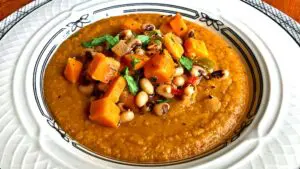In Louisiana, where I grew up, New Year’s feasting always meant Hoppin’ John, a one-pot dish of black-eyed peas, rice, a mess of smothered greens, pork and cornbread. I don’t remember missing that particular meal in the last 50 years: It remains an act of good faith for the coming year, supposedly bringing good fortune to all who partake.
First, a clarification: Black-eyed peas aren’t peas but beans, having edible seeds and pods, and have been cultivated and consumed around the world since prehistoric times.
This heat-loving, drought-, disease- and pest-tolerant crop was embraced as a staple by West Africans and is eaten there to this day. Black-eyed peas are served festively on auspicious occasions, celebrating such milestones as weddings, the birth of a child, homecomings and even funerals. Black-eyed peas were also good-luck charms in warding off the evil eye.
The “pea” traveled in a perverse/reverse Columbian exchange, with African natives enslaved by the Spanish and Portuguese (among others), transported and trafficked to bustling South American and Caribbean “economies.” This trade would ultimately extend to the American South.
Adrian Miller, a food historian and self-proclaimed “soul-food scholar,” posits this landing, particularly in the Geechee and Gullah cultures of the islands off what is now the Carolina coast. By 1700, black-eyed peas were grown across the Southeast by the enslaved and their ostensible “masters.” (Thomas Jefferson grew them in his Monticello gardens.)
Miller also addresses the issue of “luck”: In an article in Garden & Gun titled “Why Do We Eat Black-Eyed Peas on New Year’s Day?,” he suggests that it may be a cross-cultural mashup between African foodways and the traditions of another culture with an affinity for the legume: Sephardic Jews, who reportedly had a custom of eating black-eyed peas for luck on their New Year, Rosh Hashanah.
Flash forward to early April in the Highlands, and I’m feeling fortunate to have stumbled onto a bag of Super Lucky 2024 Black-Eyed Peas (from Rancho Gordo) lurking in my hoard of legumes, left over from New Year’s. While Hoppin’ John is always an option, the chilly nights called for something else, and this black-eyed pea and sweet potato soup by Joe Yonan, author of Cool Beans, seemed to fit the bill.
I particularly like the fact that it’s only half puréed — toward the end of cooking, you reserve a few cups of the beans, potatoes and other vegetables (did I mention that this recipe is vegan?) to add back after puréeing the rest, giving the final bowl a comforting chunkiness and substantiality.
It turns out that soup is like luck: The best is the kind you make yourself.

Black-Eyed Pea & Sweet Potato Soup
Adapted from Joe Yonan/The Washington Post
Makes 6 to 8 servings
- 1 cup dried black-eyed peas, soaked overnight
- ¼ cup canola oil
- 3 small tomatoes (about 12 ounces), cored, seeded and chopped
- 1 large yellow onion, diced
- 1 green bell pepper, diced
- 2 cloves garlic, minced
- ½ teaspoon cayenne pepper
- ½ teaspoon salt, plus more to taste
- 1 tablespoon white wine vinegar (substitute apple cider vinegar)
- 3 large sweet potatoes (2 to 2½ pounds), peeled and cut into ½-inch dice
- 2 cups water
- Chopped parsley for garnish
1. Drain and rinse the black-eyed peas. Heat the oil in a large pot over medium-high until it shimmers. Add tomatoes, onion, bell pepper, garlic, cayenne and salt. Cook, stirring occasionally, until onion is soft, about 10 minutes. Add the vinegar to deglaze the pot, scraping up any browned bits on the bottom of the pan.
2. Add the black-eyed peas, sweet potatoes and water and bring to a boil. Reduce heat to a simmer, cover and cook until the black-eyed peas are very soft, about 40 to 50 minutes. When peas are soft, adjust salt if necessary and remove pot from heat to cool for about 10 minutes.
3. Using a slotted spoon, transfer 2 to 3 cups of the soup solids to a small saucepan and reserve, keeping warm. Meanwhile, use a blender or food processor to purée the remainder of the soup. Return purée to the cooking pot to keep it warm.
4. Divide the puréed soup among serving bowls; top each with some of the reserved vegetables. Garnish with parsley and serve hot with warm, crusty whole-grain bread.

